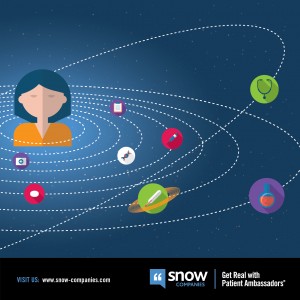At the Center of Industry’s ‘Solar System’: Five Strategies to Connect with Patients
Children and fools speak the truth, they say. When Galileo first said that the Earth travels around the Sun, he was held for a fool. When industry pundits say that patients are at the center of the life science Solar System, they, too, are sometimes accused of throwing around mere buzzwords. But that doesn’t make it any less true. Patient centricity matters for the sake of patients as much as for the sake of business. So how can it be done well?
1. Prioritize face-to-face encounters
Of course, we do market research, social listening, and a myriad of other activities to gain insights and improve business strategies. Those things are needed and necessary. However, how many of us are actually engaging patients personally? While words can convey a great deal of information, but visuals, the voice, the face, and body language all provide relevant context to what is said. Nothing shows greater respect and a higher level of interest than taking the time to be physically present and interact personally with someone. When was the last time you actually had a conversation with someone who had the condition you are working on? If that was not recent, perhaps that’s the place to start.
2. Be human
If you ask patients what’s most important to them when they choose a healthcare provider, overwhelmingly, they’re looking for someone who cares how they’re doing. For a number of reasons, pharmaceutical brands can be perceived as lifeless, cold, necessary evils. They are viewed as merely pills, injections, or infusions, and their benefits sometimes get lost in the commercial mandatories for people to only find that they can’t remember why this brand was a good idea in the first place. We shouldn’t be content with just being “necessary.” Successful brands have a human face, because they work with real people living with the disease, and they offer real support rather than just marketing messages.
3. Include care partners
A large body of literature points to the importance of close family and friends to help patients adhere to their treatment regimen and to provide for the right care at home. In some disease categories, reaching care partners is arguably more important and more appropriate than reaching the patients themselves; think of Alzheimer’s, autism, or any kind of pediatric disease, where it’s mostly physicians and care partners making the most important decisions on the patient’s behalf. A parent caring for a child with a disease will struggle with a different set of worries than someone caring for a spouse, so customization is vital. Care partners often end up being just an afterthought, but in our experience the best patient communication programs have always taken loved-ones into account early in the process. Being mindful of how an illness affects not only the person, but also those around them, is a critical consideration in the communication strategy.
4. Be relevant – tell stories
Research points to three main drivers of medical adherence: patient comprehension, recall, and motivation. Only one messaging format can address all three supporting factors to improve behavioral outcomes: stories. As studies at the University of Princeton have shown, storytelling can lead to neural coupling, where the brains of listeners essentially mirror activities happening in the brain of the storyteller. What this means is that if you hear a story, your brain comes close to actually experiencing the story. Stories get our attention, so our brains are switched on, which helps us understand and remember what we’re being told. And since stories also stimulate us emotionally, we are more open to messages that encourage certain behaviors.
5. Choose peers as messengers
The most credible messenger for any target group is a peer. Testimonials and personal recommendations by people in our inner circle have always had the strongest influence on our most important life decisions. We trust people who are just like ourselves more than total and utter strangers. Storytelling is good, but it has to be culturally appropriate; i.e. your messengers should have a similar demographical background as the target group. Don’t speak through “the average person on the street,” but through “the average person living with the condition,” or a person just like the ones you’re trying to reach.
Bottom line: Engaging with patients takes commitment and preparation. Yet, regardless of brand, it needs to be done – it’s about accepting the facts surrounding the entire healthcare universe. It’s about listening to “fools” like Galileo.

